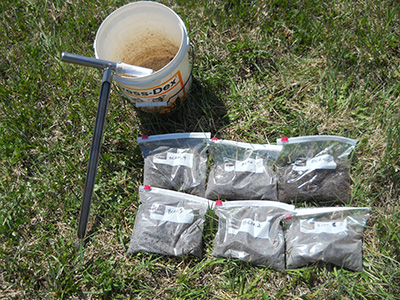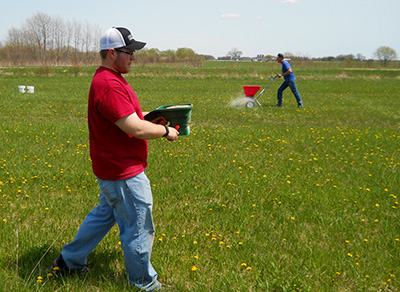Second year hay fertilizer and lime demonstration in Chippewa County
On-farm demonstration looks at second year carry-over effect of single year fertilization versus repeat fertilization in second year.

This demonstration is a continuation of the 2015 project initiated with local farmer input to compare the results of moderate annual lime application (1 ton per acre, surface applied) and various annual fertilizer rates including no fertilizer, fertilizer at “nutrient removal” rate and fertilizer at “build-up” rate based on a Michigan State University soil test. MSU Extension conducted the demonstration in cooperation with host farmers Bruce and Wayne Berkompas from Rudyard, Michigan.
Six strips were established in 2015 on a typical timothy/birdsfoot trefoil hay field on clay soil under a single cut harvest system. In 2016, these strips were each divided into two treatment sections. One section of each strip did not receive any additional lime or fertilizer in 2016. The other section of each strip was soil tested and given a lime and fertilizer treatment as in 2015, with the exception that the build-up fertilizer rate was calculated based on the new, 2016 MSU soil test report for each strip. The yield goal was set at 2 tons per acre, as it was in 2015. These treatments were intended to duplicate the approach used in 2015 on a part of each area, and leave part of each area treated in 2015 as an untreated area in 2016 to observe any carry-over effect from the 2015 fertilizer and lime treatments.

Soil samples were collected from 2016 treatment strips on May 9, 2016.
There were two main differences between the 2015 and 2016 lime and fertilizer applications.
- In 2015, 50 pounds of nitrogen (as urea) was included with crop removal and build-up fertilizer rates. This was based on a perceived low percentage of legumes present in the forage stand. During the 2015 season, it became apparent there was a 35-40 percent legume stand present, theoretically enough to provide adequate nitrogen without additional application. In 2016, no nitrogen fertilizer was included in any treatment.
- A different source of lime was used in 2016. In 2015, bagged dolomitic lime was purchased locally for the project. A local farmer donated bulk lime for 2016. A quality sample was submitted to the MSU Soil and Plant Nutrient Laboratory after the lime was applied. The results indicated that the lime included 23.3 percent moisture and a 65 percent effective calcium carbonate rating based on neutralizing value and sieve analysis. The lime was somewhat clumpy. The lime application on the treated strips in 2016 should have been increased by 80 percent to compensate for poor lime quality. Michigan Agriculture Environmental Assurance Program (MAEAP) technician Mike McCarthy from the Chippewa Conservation District and local farmer and seed company representative Jeremy Sweeten assisted with lime and fertilizer applications.

Mike McCarthy and Jeremy Sweeten spread lime and fertilizer.
Using a ballpark figure for fertilizer cost of $540 per ton, a simple economic estimate can be made to compare yield increase based on fertilizer application over 2016 only, and over 2015-2016. Fertilizer spreading cost of $7.50 per acre is included. Because the treatments were not replicated, the economic estimate should be considered as a “snapshot” for this year and location only. Yield check data will be collected from these plots in 2018 without further applications of lime and fertilizer to demonstrate the carryover impact of single-year and two-year fertilizer and lime application. Build-up rates are expected to reach the critical level in three to four years, so they are not expected to break even in the first two years.
Yield data based on 2015-only fertilizer application over 2015-2016 period |
||||
|---|---|---|---|---|
|
Fertilizer rates |
2015 yield (tons DM/A) |
2016 yield (tons DM/A) |
Total two-year yield |
Breakeven hay value to justify fertilizer cost ($/ton DM) |
|
No fertilizer |
1.6 |
1.5 |
3.1 |
|
|
Crop removal fertilizer rate:
|
2.8 |
1.6 |
4.4 |
$62.26 |
|
Build-up fertilizer rate:
|
3.1 |
1.8 |
4.9 |
$73.17 |
Yield data based on 2015 and 2016 fertilizer application |
||||
|---|---|---|---|---|
|
Fertilizer rates |
2015 yield (tons DM/A) |
2016 yield (tons DM/A) |
Total two-year yield |
Breakeven hay value to justify fertilizer cost ($/ton DM) |
|
No fertilizer |
1.6 |
1.4 |
3.0 |
|
|
Crop removal fertilizer rate:
|
2.8 |
1.8 |
4.6 |
$86.66 |
|
Build-up fertilizer rate:
|
3.1 |
2.1 |
5.2 |
$88.49 |
Summary
- As in 2015, the 2016 yield check did not suggest any difference between lime application treatments.
- Eliminating nitrogen from the 2016 fertilizer applications apparently resulted in reduced response in hay yield compared to 2015, when 50 pounds per acre of nitrogen was included. This suggests the existing legume component in the hay may not have provided enough nitrogen to optimize hay yield.
- Yields based on 2015-only application of fertilizer suggests carry-over impact on yield into 2016.
- Repeat annual applications of crop removal and build-up rates in 2015 and 2016 suggest improved hay yields compared to 2015-only fertilization, but at a higher cost per ton of dry matter (DM) than a single application over the same period.
This demonstration suggests fertilizing at crop removal or build-up rate every other year may provide a more economic approach to increasing hay yields than annual application in this type of system and environment. Including 50 pounds nitrogen per acre when fertilizing may improve yields substantially at a relatively low cost.
To read more about the 2015 project, see “Hay fertilizer and lime demonstration in Chippewa County.”



 Print
Print Email
Email